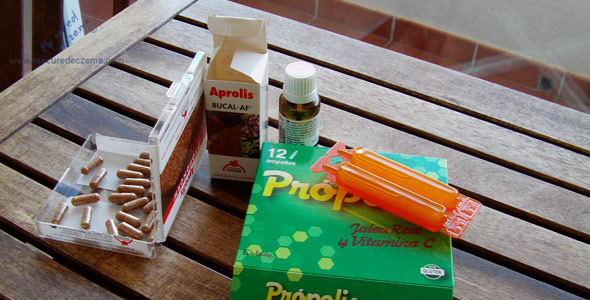Propolis (bee glue)
As I mention in my eczema story, I have literally tried everything on earth that was promising to be finally THE cure for eczema. After honey, I found very appealing commments and reviews on another product from the factory of the diligent bees called propolis. So again as always, I walked into my favorite bio-shop and asked for it. I was already full of information about it as I made my homework and studied propolis in details at home on the internet beforehand. This is just me, I always have to understand how everything works and why, etc.

It comes in ointments, and also syrups or capsules. I bought it in the form of capsules that you can see in the picture above. I was using in 2 times daily 3 capsules a day in a duration of two weeks. Unfortunatelly, I didn't experience any effect or significant relieve from my eczema worth to mention. I also tried a very concentrated propolis oinment, but to no avail either.
The oinment only made my skin dark-yellowish and I need to tell you that it is not easy to clean off at all. That was also a big drawback for me, as my eczema was on fingers, which are always visible to people. However, I need to say that I still believe in the health benefits of quality products containing propolis. For example, my brother successfuly used it to heal is never-ending problem with inflammation on the big toe of his left foot. Having said that, it is useful, only that it seems not to be the answer for eczema issues.
More details
Propolis is a resin like substance gathered from the bark and leaf buds of trees by bees. It is used to reinforce the stability and seal alternate entrances (for easier defence). It's a great anti-fungal, anti-bacterial and anti-parasitic properties make it a perfect protecting material, playing a key role in the world of bees.
Bees are opportunists and the material needed for their hives is constructed from available sources that surround them, which is the main reason behind differences of colors and chemical structures of propolis in various regions. Among more than 50 items, the key material components include vegetable balsams (50%), waxes (30%), essential oils (10%), and pollen(5%).
Pollen can be found in health-shops as well, but as far as I know it doesn't have any significant proofs of its benefits for human consumption. As a curiosity I would like to add that although spiders are normally carnivores, some species use pollen as a significant part of their daily food menu. In conclusion, there are still not enough studies to definitelly prove how much of a beneficial effect propolis can have on our health.
Some studies have some good news, but it still doesn't seem enough for the opponents of this bees' product. However, I think it's important to keep in mind that there has to be something good behind, only because it's been used throughout all our history by various cultures in the world.
IMPORTANT: To get the whole routine I used to fight my eczema, simply join my group of subscribers in the upper right-hand corner.
